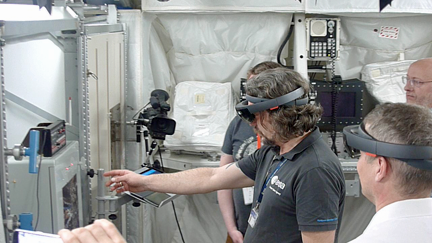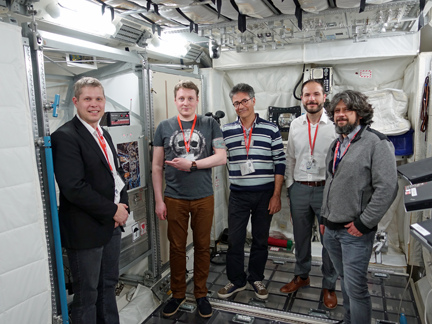 VTT is participating in the development of new augmented reality (AR) tools for the European Space Agency (ESA)
VTT is participating in the development of new augmented reality (AR) tools for the European Space Agency (ESA)
An augmented reality demonstration underway in the ISS’s Columbus research laboratory.
Photographer: Domenico Tedone, Thales-Alenia Space, Italy.
In the future, it is envisaged that astronauts will be able to use this AR tool to perform maintenance tasks and real-time equipment monitoring in the demanding conditions of space. The first practical tests carried out at ESA’s European Astronaut Centre produced excellent results.
The two-year EdcAR project (Engineering data in cross platform AR) led by VTT developed a solution to the challenges involved in maintenance and the provision of work instructions, which have been an issue for more than a decade. As maintenance and other work tasks in space are critical, they must be carried out without errors and at the right time. Preparing for these requires in-depth practicing, which involves coordinating the activities of various experts. Since astronauts’ time is extremely valuable, their tasks and maintenance instructions must be unambiguous.

The ESA-EdcAR project team (left to right): Kaj Helin VTT, Jaakko Karjalainen VTT, Domenico Tedone Thales-Alenia Space, Spyros Bolierakis ICCS, David Martinez Oliveira ESA.
Photographer: Frank Nicolini, ESA/EAC, Germany.
The EdcAR project developed a new AR system intended to improve the performance of manual tasks in the frame of the Space Industry. The system is expected to reduce mistakes, speed up the tasks and improve the clarity of the instruction by the use of AR technology. The major benefit is the real-time location of the point requiring maintenance. This information is transmitted to the astronaut's AR glasses explicitly and at the right time by using text, graphics, video, sound etc. The system displays detailed visual instructions on the astronauts' AR glasses, guiding them step by step to perform the necessary procedures in the right order, such as “now press this button,” “then turn the lever (B).”
The new system also makes the invisible visible by enabling the visualization of telemetry data from equipment and other systems on board the space station, such as fault diagnostics, the latest maintenance data, life cycle, radiation, pressure or temperature — both in space and on the ground. All of this information can be displayed on the AR glasses.
The first practical tests of the new AR systems have been performed in the ISS-Columbus training mock-up located in the ESA’s on-ground European Astronaut Centre (EAC) in Cologne, Germany. The test team included an experienced astronaut. The AR system can be applied in a number of sectors, such as the aviation industry, machine building, ships, mining machines and power plants.
The two-year project was funded by ESA. The project partners are VTT Technical Research Centre of Finland, Thales Alenia Space, Italy and France, and ICCS (Institute of Communications and Computer Systems), Greece.
Project Manager Kaj Helin of VTT explained that the AR system that the company developed runs on the Microsoft HoloLens platform and supports the astronauts’ work in a completely new way by displaying key telemetry data through an IoT (Internet-of-Things) interface.

